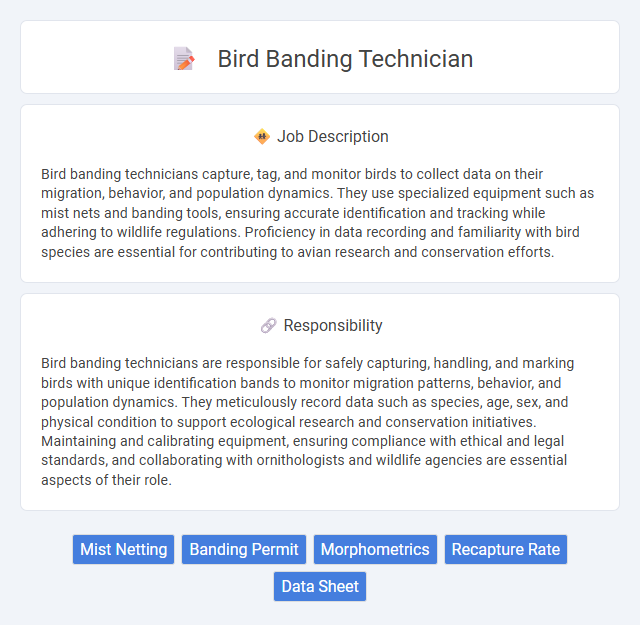
Bird banding technicians capture, tag, and monitor birds to collect data on their migration, behavior, and population dynamics. They use specialized equipment such as mist nets and banding tools, ensuring accurate identification and tracking while adhering to wildlife regulations. Proficiency in data recording and familiarity with bird species are essential for contributing to avian research and conservation efforts.
Individuals with a strong interest in wildlife and good physical stamina will likely find bird banding technician roles well-suited to their skills, as the job often requires fieldwork involving walking, climbing, and handling birds carefully. Those who may not adapt easily to working outdoors in various weather conditions or who have difficulty with meticulous data recording might face challenges in this role. A passion for conservation combined with patience and attention to detail can significantly increase the probability of success and satisfaction in this position.
Qualification
A Bird Banding Technician position requires strong expertise in ornithology, proficiency in safe bird handling techniques, and experience with banding protocols to accurately collect data for avian research. Candidates typically need a bachelor's degree in wildlife biology, ecology, or a related field, along with skills in data recording, species identification, and fieldwork in diverse environmental conditions. Physical stamina and attention to detail are essential for tracking migratory patterns and maintaining compliance with federal wildlife regulations.
Responsibility
Bird banding technicians are responsible for safely capturing, handling, and marking birds with unique identification bands to monitor migration patterns, behavior, and population dynamics. They meticulously record data such as species, age, sex, and physical condition to support ecological research and conservation initiatives. Maintaining and calibrating equipment, ensuring compliance with ethical and legal standards, and collaborating with ornithologists and wildlife agencies are essential aspects of their role.
Benefit
Working as a Bird Banding Technician likely offers valuable field experience in wildlife research and conservation, enhancing skills in species identification and data collection. The role probably provides opportunities to contribute directly to avian population monitoring and ecological studies, which can be beneficial for career advancement in environmental sciences. Benefits may also include close interaction with trained biologists, fostering professional networking and specialized knowledge in ornithology.
Challenge
A bird banding technician job likely involves the challenge of working in varying and often unpredictable outdoor environments, which may affect daily operations and data collection. The role probably demands meticulous attention to detail and precision in handling delicate birds to ensure safety and accurate banding. Adapting to fluctuating weather conditions and managing the physical endurance required for repetitive tasks could present ongoing obstacles.
Career Advancement
Bird banding technician roles provide critical experience in avian research, data collection, and wildlife monitoring, essential for career growth in ornithology and conservation biology. Mastery of field techniques, species identification, and data analysis enhances opportunities for advancement to research scientist or wildlife biologist positions. Specialized skills in bird banding methodology and permit handling increase competitiveness for leadership roles in environmental agencies or academic research projects.
Key Terms
Mist Netting
A Bird Banding Technician specializing in mist netting plays a crucial role in avian research by safely capturing birds for banding and data collection. Expertise in setting up, monitoring, and dismantling mist nets ensures minimal stress to birds while maximizing capture efficiency. Proficiency in species identification, data recording, and adherence to ethical guidelines supports conservation and population monitoring efforts.
Banding Permit
A Bird Banding Technician must obtain a federal Banding Permit issued by the U.S. Geological Survey Bird Banding Laboratory or the corresponding authority in their country. This permit ensures legal authorization to capture, band, and release birds for scientific research and monitoring. Compliance with permit requirements promotes responsible bird handling and contributes to avian conservation efforts.
Morphometrics
Bird banding technicians specializing in morphometrics collect and analyze detailed physical measurements of birds, such as wing length, bill size, and weight, to monitor species health and population trends. Precise data collection supports ecological research, tracking growth patterns, and identifying morphological variations across habitats and seasons. Expertise in handling birds efficiently while ensuring accurate recording of morphometric data is essential for advancing avian conservation efforts.
Recapture Rate
Bird banding technicians play a critical role in monitoring avian populations by capturing, ringing, and releasing birds to track their movements and behaviors. The recapture rate, a key metric in this job, reflects the proportion of previously banded birds that are caught again, providing essential data on survival rates, migration patterns, and population dynamics. High recapture rates enhance the accuracy of population models and contribute to effective bird conservation strategies.
Data Sheet
A Bird Banding Technician is responsible for accurately filling out data sheets that record detailed information on bird species, band numbers, capture location, date, and physical measurements. These data sheets are essential for tracking migration patterns, population dynamics, and long-term ecological studies. Precision and consistency in data entry directly impact the quality of research and conservation efforts.
 kuljobs.com
kuljobs.com